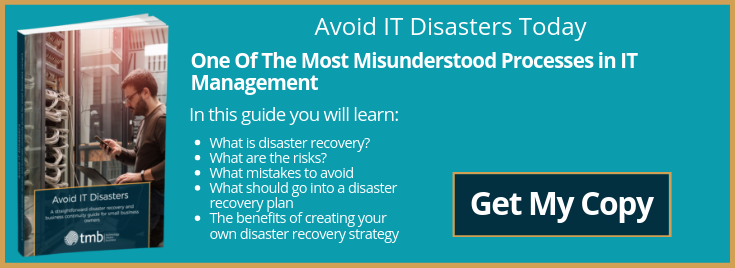Disaster Recovery: How Much Time Is It Worth?
Whether it is a ransomware attack, equipment failure, or an honest mistake, IT disasters happen all the time. The headlines speak for themselves: “We’re on our knees,” pleaded TSB in 2018, after a network upgrade led to millions of customers being denied access to their accounts. T-Mobile, Google, Facebook, and Quora all faced costly and embarrassing breaches, flouting protocol in a year that was dominated by the strict GDPR rollout. Are you prepared if an IT security disaster were to strike your business? Read on to find out.
Disaster Recovery: What’s Involved?
Disaster recovery is a specialised art that involves several steps. These can be broadly summarised in three key stages:1) Understand The Threats
A company needs to carry out detailed risk assessments that identify general and unique hazards. Hazards are likely to include risks posed by employees accessing your network from outside the office, aging software, data storage vulnerabilities and resilience to targeted attacks. Technology – and criminal abilities – evolve at lightning pace, so these risks and hazards constantly change and need to be regularly assessed and updated.2) Respond To The Threats
Each identified threat may require a different solution. Updating software and setting up real-time cloud-based data backup systems are reliable threat-response strategies, but you will also find that security protocols need to be tightened.3) Plan & Practice
Do you know how to respond if a ransomware attack suddenly takes your organisation offline? For unprepared businesses, the aftermath is usually chaotic and panicked. Business continuity is disrupted, customers and clients are frustrated and worried, and profits experience an uncontrolled nosedive. Prepared organisations plan so that they know exactly what to do, and have systems in place that automatically have the business up and running again in a matter of moments.How Do I Make A Disaster Recovery Plan?
When it comes to planning, the more time and effort you put in, the better. If you’re planning to do everything in-house, there’s plenty of generic advice online. However, each business is unique, so use pre-formatted plans as guidance only. Staffing credentials and finding software that works with your existing systems are likely to be the main headaches, although rigorous threat and hazard analysis also require lots of time and effort. If you choose to outsource, most of the work is done for you. The disaster recovery provider will already have the data backup and recovery systems in place and will use teams of experts to keep these updated. These systems keep you safe, but also enable business continuity by getting you moving again quickly. Disaster recovery providers will also work with you to analyse particular threats and responses, so you have a bespoke approach combined with an in-house action plan. Once your plan has been made, this can be practised, a bit like a fire drill.Find Out More
Disaster recovery is something to take seriously. In the past, businesses were lost due to fires and floods. Today, they are lost due to IT failure. Whether you prepare in-house or outsource, disaster preparedness is part of basic digital era responsibility. To learn more, start by downloading our free Disaster Recovery Guide.



